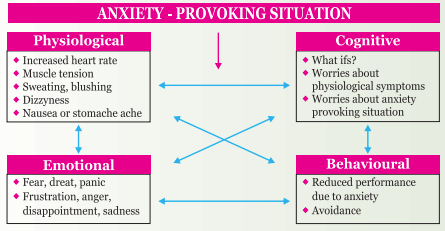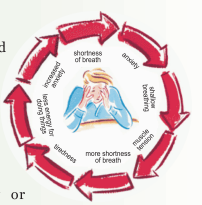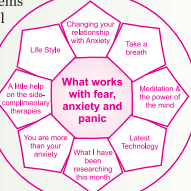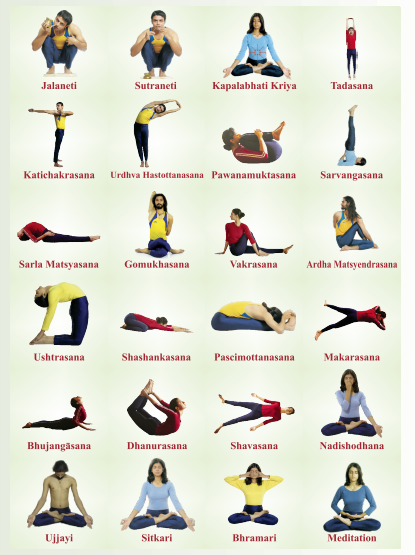Yogic Management of Anxiety Disorder
Yogic Management of Anxiety Disorder
Introduction
Anxiety is an unpleasant state that involves a complex combination of emotions that include fear, apprehension, and worry. It may exist as a primary brain disorder or may be associated with other medical problems including other psychiatric disorders. It is often accompanied by physical sensations such as heart palpitations nausea, Chest pain, shortness of breath, or tension headache.
Anxiety is often described as having cognitive, somatic, emotional, and behavioral components. The cognitive component entails expectation off a diffuse and uncertain danger. Anxiety is a normal reaction to stress. It helps one deal with a tense situation in the office, study harder for an exam, keep focused on an important speech. In general, it helps one cope. But when anxiety becomes an excessive, irrational dread of everyday situations, it has become a disabling disorder.
Anxiety Disorder
A category of disorders described in the DSM-IV in which a person experiences anxiety so extreme that it interferes with functioning. Anxiety disorder is a blanket term covering several different forms of fear. Phobia and nervous condition that come on suddenly and prevent pursuing normal daily routines.

Symptoms
Anxiety symptoms produce a frightening and uncomfortable physical and emotional state ranging from mild unease to intense fear and panic. A baseline' level of anxiety is quite normal, but excessive or inappropriate anxiety can cause anxiety symptoms develop which become unpleasant. It becomes imperative to take necessary action to adjust the anxiety back to a normal level.
Anxiety has three components
Firstly, there is a psycho-physiological (physical) component which produces anxiety symptoms such as palpitations (racing heat), breathlessness, dizziness and sweating.
Secondly, there is a psychological component which produces anxiety symptoms such as irritability, obsessions, lack of concentration, deep feelings of fear.
Finally, there may be an interpersonal component featuring an inclination to cling to other people for reassurance.
Symptoms of ANXIETY:
 Common symptoms of anxiety are:
Common symptoms of anxiety are:- Smothering sensations and shortness of breath
- Racing heart, slow heart beat, palpitations Chest Pain
- 'Lump in throat' & difficulty swallowing
- Excessive Perspiration (Sweating)
- Shaking or shivering (visibly or internally)
- Pain or numbness in the head, face, neck or shoulders
- Indigestion, heartburn, constipation and diarrhea
- Sexual Dysfunction Dry mouth
- Insomnia Nightmares
- Fears of going mad or losing control
- Increased depression & suicidal feelings Aggression.
Causes
The exact cause of anxiety disorder is not fully understood. Reserch suggests that it may be due to a combination of several factors. These may include:
- Over-activity in area of the brain responsible for emotions and behavior.
- An imbalance of the brain chemicals such as serotonin and noradrenaline, which are involved in the control and regulation of mood.
- Heredity: Genes you inherit from your parents - you're estimated to be five times more likely to develop GAD if you have a close relative with the condition.
- History of stressful or traumatic experiences, such as domestic violence, child abuse or bullying.
- Painful long-term health condition, such as arthritis having a history of drug or alcohol misuse.
Management
Psychological aspect :
- Self-help : One may be able to improve his/her symptoms by using relaxation techniques, exercise or by talking to other people in support groups.
- Counselling : This involves talking through problem with a Counselor, who can help to focus on what one want to do and how one can achieve that goal.
- Cognitive behavioural therapy (CBT) : Cognitive therapy involves assessing the reasoning behind thinking - it is based on the idea that abnormal thinking results in abnormal reactions.
- Medicines : Tranquilisers, may help to relieve some short-term stress-related anxieties. However, they shouldn't be taken for long periods because of the risk of addiction.
- Relaxation : Relaxation training is a feature of some types of psychotherapy. Various types of relaxation therapy are available.
- Complementary therapy : Although there are a wide variety of complementary therapies available for the treatment of anxiety, none have been conclusively proven to work and they may have side-effects.
Physical Aspect
 Exercise can help to relieve stress, tension and anxiety. By expelling the excess negative emotions and adrenaline through physical activity, one can enter a more relaxed, calm state of being. Exercise is one of the most important coping medium to combat anxiety and stress. It acts as a buffer against stress and may thus help protect the cardiovasular and immune systems from the consequences stressfull events.
Exercise can help to relieve stress, tension and anxiety. By expelling the excess negative emotions and adrenaline through physical activity, one can enter a more relaxed, calm state of being. Exercise is one of the most important coping medium to combat anxiety and stress. It acts as a buffer against stress and may thus help protect the cardiovasular and immune systems from the consequences stressfull events.
Exercise seems to elevate mood both through its physiological effects on the nervous system and through its direct psychological effects. It provides a distraction from everyday concerns and offers an opportunity for positive fantasy.
Nutritional aspect
Refined, white flour and sugar products and processed foods starve the body of B Vitamins. This weakens the body and promotes feelings of anxiety. Sweet foods are especially harmful, since their digestion causes a dramatic drop in blood sugar which can be experienced as apprehensive jitteriness. Take a healthy, whole foods diet containing fresh vegetables and fruits, nuts and whole grains. Fruits and vegetables are best eaten raw, such as in a salad. Honey dissolved in warm milk also has a calming effect on the nerves. Avoid alcohol, caffeine, and sugar as they worsen anxiety.
Yogic Management
The line of treatment should be to retard the hyperactive state of mind. The Yogic practices prescribed are :
Kriyas : Jalnti, Sutraneti, Kapalabhati (mild strokes) Suryanamaskar Yogic
Sukshma vyayama and sthula vyayama : Medha shakti vikasaka kriya, Smarana shakti vikasaka kriya, Buddhi tatha dhriti shakti vikasaka kriya, Urdhwagati.
Yogasana : Tadasana, Katichakrasana, Pavanamuktasana, Sarvangasana, Sarala Matsyasana, Gomukhasana, Vakrasana, Ardhamastsyendrasana. Ushtrasana, Shashankasana, Paschimo- ttanasana, Makarasana, Bhujangasana, Dhanurasana, Shavasana.
Pranyama : Nadishuddi, Ujjayi, Sitali/Sitkari and Bhramari. Meditation: Breath awareness, Om chanting and Om meditation.
Note : Yoga Nidra will be helpful as this practice is believed to act on the subconscious level to bring about a state of homeostasis in the body and mind.
Contraindications : The dynamic practices, hyperventilation breathing etc. should be avoided.
- Persistent sad, anxious, or "empty" mood
- Feeling of hopelessness, pessimism
- Feelings of guilt, worthlessness, helplesssness
- Loss of interest or pleasure in hobbies and activities that were once enjoyed, including
- decreased energy, fatigue, being "solved down"
- Difficulty concentrating, remembering, making decisions
- Insomnia, early-morning awakening, or oversleeping
- Appetite and/or weight changes
- Thoughts of death or suicide, or suicide attempts
- Restlessness, irritability
Yogic Practices for the Management of Anxiety

Last Modified : 8/31/2023
This topic provides information about Desktop Yoga...
This topic provides information about The Role of ...
This topic provides information about Managing Pep...
This topic provides information about Yoga for Epi...
